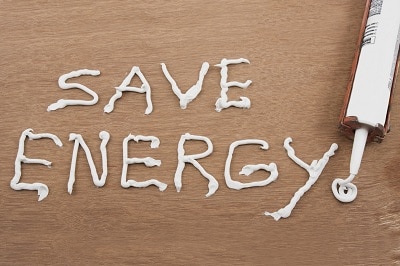How to Seal Air Leaks in Your Home, Part 1: Choosing the Right Caulk

Sealing air leaks in your home to reduce money off monthly utility bills can be a confusing and messy proposition. After all, staring down the barrel of a caulking gun can be intimidating unless you know what you’re doing. There are lots of different caulking compounds for different jobs; they can be messy, gooey and need to be properly applied. But with the right caulk and the right technique, even the most novice do-it-yourselfer can easily seal cracks and gaps and start cutting energy costs right away.
The first step in sealing your home’s air leaks is choosing the right kind of caulking compound. There are lots of different caulks, including household silicone, construction silicone, expandable spray foam polyurethane, water-based foam sealant, butyl rubber, latex and oil- or resin-based caulks. To help you determine the caulk you need, here’s a quick summary of the different types available:
Household Silicone
Household silicone caulk is used to seal joints between bath and kitchen fixtures and tile and to seal metal joints in plumbing and gutters. Joints can stretch up to three times their original size or compress by half without cracking.
Adhesion: Good to excellent
Shrinkage: Little or none
Cleanup: Dry cloth immediately, otherwise mineral spirits or naphtha
Cost: High
Construction Silicone
Construction silicone is used to seal dissimilar materials, such as wood and stone or metal and brick. Joints can stretch or compress without cracking and construction silicone will adhere to painted surfaces but not most cured silicones.
Adhesion: Good to excellent
Shrinkage: Little or none
Cleanup: Dry cloth immediately, otherwise mineral sprits or naphtha
Cost: High
Expandable Spray Foam Polyurethane
Expandable spray foam polyurethane is good for sealing larger cracks indoors or outdoors. The foam quickly expands to fill even irregular gaps. Make sure to paint over it when used outside to provide protection from ultraviolet radiation. One downside: the rubber becomes dry and powdery over time, so it’s best to use in areas that don’t receive any friction, like a wall crack.
Adhesion: Good to excellent
Shrinkage: None; it expands significantly
Cleanup: Lacquer thinner or other solvent applied immediately
Cost: Moderate to high
Water-Based Foam Sealant
Water-based foam sealant is also designed to expand to fill gaps and cracks, but because it doesn’t expand as much as polyurethane, it’s best for smaller cracks and gaps. It’s typically used around window and door frames in new home constructions. It takes 24 hours to cure and needs to be exposed to air to dry.
Adhesion: Good to excellent
Shrinkage: None; it expands by about 25 percent
Cleanup: Water
Cost: High
Butyl Rubber
Butyl rubber is used to seal dissimilar materials, around windows and flashing and to bond loose shingles. It’s durable, lasting 10 or more years, and resilient, but variable shrinkage means you may have to apply it twice. It can be painted over after a week of curing. Unfortunately, it doesn’t adhere well to painted surfaces and is toxic, so you’ll need to follow precautions listed on the product label.
Adhesion: Good
Shrinkage: From 5 percent to 30 percent
Cleanup: Mineral spirits or naphtha
Cost: Moderate to high
Latex
Probably the most common type of caulking compound used by do-it-yourselfers around the home, latex caulk is used to seal joints around tubs and showers and to fill nail holes and cracks in tile, plaster, glass and plastic. Latex is easy to use and seams can be smoothed with a finger or a simple smoothing tool. After latex dries, it becomes waterproof, allowing for sanding and painting.
Adhesion: Good to excellent
Shrinkage: From 5 percent to 10 percent
Cleanup: Water
Cost: Moderate
Oil- or Resin-Based
Oil- or resin-based caulks are used to seal exterior seams and joints on buildings. These compounds are readily available and cheap, but not especially durable (they last about one to four years). When they dry, the caulk hardens and parts of it fall out. These compounds can also be toxic, so read the product labels carefully.
Adhesion: Good
Shrinkage: From 10 percent to 20 percent
Cleanup: Mineral spirits or naphtha
Cost: Low
Now that you have the information you need to choose the right caulking compound to seal air leaks in your home “and any other gap-sealing and crack-filling jobs you may have around the house” check out part two of our discussion for tips on applying to caulk that make it as easy, effective and mess-free as possible.
Sources
U.S. Department of Energy, Caulking.
Also Read:
How Changing Fan Direction can Help you Save Energy



